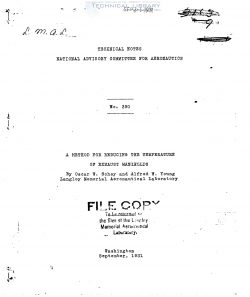naca-tn-390
- Version
- 103 Downloads
- 671.96 KB File Size
- 1 File Count
- November 24, 2016 Create Date
- November 24, 2016 Last Updated
National Advisory Committee for Aeronautics, Technical Notes - A Method for Reducing the Temperature of Exhaust Manifolds

This report describes tests conducted at the Langley
Memorial Aeronautical Laboratory on an "air—inducting" ex—
haust manifold for aircraft engines. The exhaust gases
from each cylinder port are discharged into the throat of
an exhaust pipe which has a frontal bellmouth. Cooling
air is drawn into the pipe, where it surrounds and mixes
with the exhaust gases. Temperatures of the manifold , :4
shell and of the exhaust gases were obtained.in flight for
both a conventional manifold and the air—inducting-mani—‘
fold. The air-inducting manifold was installed on an en-
gine wh -ich was placed on a test stand. Different fuels
were sprayed on and_into the manifold to determine whether
the use of this manifold reduced the fire hazard.
The flight tests showed reductions in manifold teme
poraturus of several hundred degrees,-to values below the
ignition point of aviation gasoline. On the test stand
when the engine was run at idling speeds fuels sprayed in-
to the manifold ignited. It is believed that at low engine
speeds the fuel remained in the manifold long enough to
become thoroughly heated, and was then ignited. by the ex—
haust gas which had not_mixed with cooling air.
The use of the air—inducting exhaust manifold must
reduce the fire hazard by virtue of its lower operating
temperature, but it is not a completelv satisfactory solu—
tion of the problem.
Airplane engine—exhaust manifolds which are hot enough
to ignite the fuel or lubricating oil spilled on them are a
serious fire hazard. A leak in fuel or oil lines, or a
crash which might not otherwise be serious, may cause fuel
or oil to come in contact with the hot-enhanst-manifolds
and start a fire.
Experiments at this laboratory in which samples of
different aircraft fuels and lubricating oils have been in
dropped onto heated metal surfaces have shown that igni—
tion will not occur under a temperature of about 1.2500 F.
for aviation gasoline, 880° F. for Diesel fuel oil, and
840° F. for lubricating oil. Kfihn gives values of 1,0400F.
for gasoline. 1.1100 F. for Diesel oil, and 950° F. for
lubricating oil. (Reference 1.) Differences in the meth— if
ode used and in the samples tested may easily explain the
variation in the temperatures determined.
| File | Action |
|---|---|
| naca-tn-390 A Method for Reducing the Temperature of Exhaust Manifolds.pdf | Download |
Comment On This Post